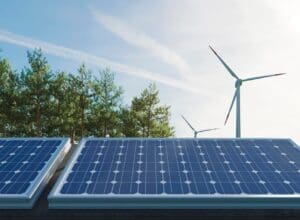 Supply chain sustainability has become a very hot topic, but for a lot of people, there is uncertainty around its meaning. Now, more than ever, companies and countries are looking at their overall carbon footprint and trying to establish a path to be more environmentally friendly. A few ways companies can begin to offset their carbon footprint is to take a deeper look at product packaging, energy efficiency, alternative fuels, route optimization, and returns and recycling programs. However, sustainability in logistics goes well beyond these initiatives, especially when we begin to look at energy transition.
Supply chain sustainability has become a very hot topic, but for a lot of people, there is uncertainty around its meaning. Now, more than ever, companies and countries are looking at their overall carbon footprint and trying to establish a path to be more environmentally friendly. A few ways companies can begin to offset their carbon footprint is to take a deeper look at product packaging, energy efficiency, alternative fuels, route optimization, and returns and recycling programs. However, sustainability in logistics goes well beyond these initiatives, especially when we begin to look at energy transition.
A recent ARC survey looked at reasons to address sustainability. This survey included over 400 respondents across a number of industries. There are three responses in this question that address supply chain sustainability: align with our goals, mission, and values; meet consumers expectations; and increase profitability.
However, in practicality, aligning one’s goals with its partners can be difficult. In a recent survey by APQC, which looked at supply chain sustainability, at the median, only 42 percent of respondents screen new logistics providers using environmental sustainability criteria and only 50 percent regularly assess existing logistics providers for environmental sustainability. And even looking at those companies that perform in the 75th percentile, that number is not much higher. Logistics providers contribute to the total picture of sustainability for many organizations, and they are clearly falling short.
The second reason to address sustainability topics, from a supply chain perspective, is to meet consumer expectations. Consumer expectations are constantly shifting and challenging the industry. For example, most people expect free next-day delivery for online purchases as a result of Amazon Prime. And more consumers are looking at sustainability as a key motivator for purchasing. More and more retailers are giving consumers choices for how they want an order delivered, and part of this is to show the environmental impact of the option that they choose. On top of that, some retailers are developing sustainability scorecards for items, allowing consumers to see hoe sustainably sourced and delivered their order is.
The third reason to address sustainability is to increase profitability. The fun thing about supply chains and sustainability is that they have a symbiotic relationship. Supply chain sustainability increases profitability. This is especially true when looking at route optimization, asset utilization, real-time visibility, energy savings, waste reduction, and efficiency. Looking at the example of route optimization, as a company takes more trucks off the road, or reduces the number of miles driven, it is better for carbon emissions, but also for profitability.
When looking at energy transition in the supply chain, there are two big opportunities to look at: warehousing and transportation. Modern warehouses play a big role in energy transition within the supply chain. Energy transition can be broken down into a few categories: energy efficient warehouse design; renewable energy usage; smarter warehousing solutions; and waste reduction.
Energy Transition in Warehousing
Modern warehouses take design into account for sustainability. This includes the use of enhanced insulation for better temperature control, which results in less power usage. Additionally, modern warehouses use energy efficient lighting to reduce power consumption. Warehouses are also harnessing alternative energy solutions, including solar and wind power. Many warehouses now have solar panels lining the roof to generate electricity to be used in the warehouse.
Modern warehouses are also utilizing smarter warehouse solutions for sustainability. This includes automation within the warehouse such electric autonomous mobile robots as well as hybrid or electric forklifts. Finally, warehouses are placing an increased emphasis on waste reduction. This comes in the form of eliminating unnecessary packaging materials and doing a better job of recycling. Too often, warehouses use boxes to ship items that require a lot of additional packaging. Now, companies are turning to the use of machinery to create made-to-fit boxes for more efficient fulfillment shipping.
Energy Transition in Transportation
On the transportation side of things, energy transition applies to all modes, with the most interest in over the road trucking. The trucking industry has been making the shift to electric vehicles for first, middle, and last mile deliveries. The use case has been most evident in last mile, as more and more companies are investing in electric delivery vehicles and e-bikes. Amazon, for example, has purchased over 100,000 Rivian electric vehicles for deliveries. But long-haul trucking is also developing electric trucks. And while Tesla has received the most attention for its electric semi-trucks, Daimler, Freightliner, and Volvo, to name a few, have also produced all electric trucks.
Ocean shipping can play a big role in sustainability and energy transition. Knowing which source of freight-related emissions are the highest can lead to improved decision making in shipping decisions. For example, air shipments are the worst in terms of carbon emissions, releasing 63 times the emissions when transporting goods of the same weight over the same distance. A transition to sustainable aviation fuel could make a difference. There are times when air freight is the best option; however, if shipments can wait, ocean shipping is cheaper and more reliable. It is also the best play for long term sustainability. As ships, and the fuel that drives them, become more environmentally friendly, the reduction in carbon emissions is important for mitigating ocean acidification. This, in turn, is important for protecting marine species, ecosystems, and industries like fisheries and tourism.
Clearly, renewable energy from alternative fuels can play an important role as organizations seek to reduce greenhouse gas emissions. However, according to an APQC survey, as a percentage of the total fuel consumed in transportation and warehousing, respondents report that currently only 7 percent comes from renewable sources (at the median).
Energy Transition Challenges
There are certainly challenges that the industry faces when it comes to energy transition in the supply chain, especially in the transportation sector. Decarbonizing transportation will be a challenge of epic proportions. The Congressional Budget Office (CBO) published a report on transportation sector emissions in December of 2022. The largest source of emissions of CO2 in the United States is the transportation sector. This sector is responsible for 38 percent of all CO2 emissions, and the next largest industrial sector – electric power generation – accounted for 33 percent. The transportation sector can’t make sufficient progress, even if the nation moves totally to electric vehicles, unless the electric sector also makes progress by dramatically reducing the amount of electricity produced by natural gas and coal.
Another challenge facing the transportation sector is infrastructure. Currently, electric semi-trucks have a range of 500 miles at most. As of now, the infrastructure on American highways cannot support fleets to go all electric. The advancement of technology plays a role in the problem. While it could take 5 years to build out the infrastructure, by then, the range of trucks will likely be significantly longer. It becomes a challenge to build for the future with the trucks of today.

















 The
The 